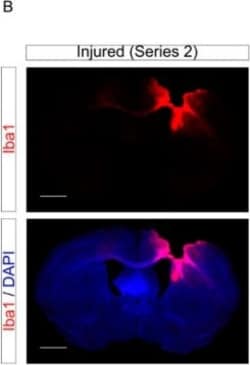Learn More
Invitrogen™ Goat anti-Guinea Pig IgG (H+L) Highly Cross-Adsorbed Secondary Antibody, Alexa Fluor™ 647
Goat Polyclonal Secondary Antibody
Marke: Invitrogen™ A21450
342.00 EUR gültig bis 2025-12-31
BESTER Aktionspreis! Benutzen Sie den Promotions-Code "24159" um Ihren Promotions-Preis zu erhalten.
Beschreibung
To minimize cross-reactivity, these goat anti-guinea pig IgG (H+L) whole secondary antibodies have been affinity purified and cross-adsorbed against bovine, chicken, goat, hamster, human, mouse, rabbit, rat, and sheep sera prior to conjugation. Cross-adsorption or pre-adsorption is a purification step to increase specificity of the antibody resulting in higher sensitivity and less background staining. The secondary antibody solution is passed through a column matrix containing immobilized serum proteins from potentially cross-reactive species. Only the nonspecific-binding secondary antibodies are captured in the column, and the highly specific secondaries flow through. The benefits of this extra step are apparent in multiplexing/multicolor-staining experiments (e.g., flow cytometry) where there is potential cross-reactivity with other primary antibodies or in tissue/cell fluorescent staining experiments where there are may be the presence of endogenous immunoglobulins. Alexa Fluor dyes are among the most trusted fluorescent dyes available today. Invitrogen™ Alexa Fluor 647 dye is a near-infrared-fluorescent dye with excitation ideally suited to the 647 nm laser line. For stable signal generation in imaging and flow cytometry, Alexa Fluor 647 dye is pH-insensitive over a wide molar range. Probes with high fluorescence quantum yield and high photostability allow detection of low-abundance biological structures with great sensitivity. Alexa Fluor 647 dye molecules can b...
Anti-Guinea Pig secondary antibodies are affinity-purified antibodies with well-characterized specificity for guinea pig immunoglobulins and are useful in the detection, sorting or purification of its specified target. Secondary antibodies offer increased versatility enabling users to use many detection systems (e.g. HRP, AP, fluorescence). They can also provide greater sensitivity through signal amplification as multiple secondary antibodies can bind to a single primary antibody. Most commonly, secondary antibodies are generated by immunizing the host animal with a pooled population of immunoglobulins from the target species and can be further purified and modified (i.e. immunoaffinity chromatography, antibody fragmentation, label conjugation, etc.) to generate highly specific reagents.
Spezifikation
| Guinea Pig IgG (H+L) Highly Cross-Adsorbed | |
| Polyclonal | |
| Alexa Fluor 647 | |
| Goat | |
| Purified | |
| RUO | |
| Guinea Pig | |
| Secondary Antibody | |
| IgG |
| Immunohistochemistry, Western Blot, Immunocytochemistry | |
| 2 mg/mL | |
| PBS with 5mM sodium azide; pH 7.5 | |
| Gamma Immunoglobins Heavy and Light chains. | |
| 1 mg | |
| Secondary | |
| 4°C, store in dark | |
| Liquid |
Bitte geben Sie uns Ihr Feedback zu den Produktinhalten, indem Sie das folgende Formular ausfüllen.















